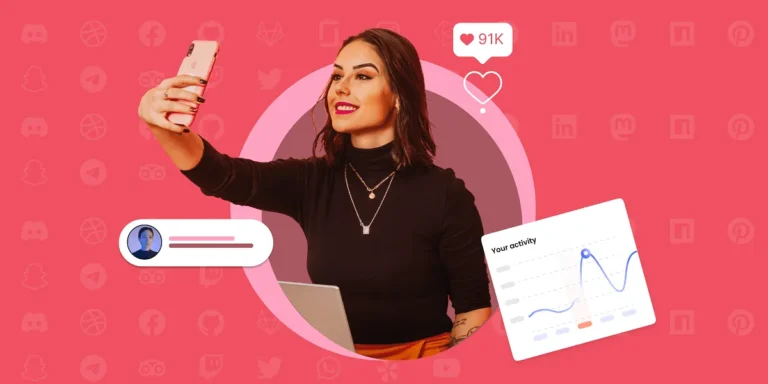
Influencer Marketing
In today’s digital landscape, influencer marketing has emerged as a powerful and effective strategy for businesses of all sizes to reach new audiences, build brand awareness, and drive sales. With the rise of social media platforms like Instagram, YouTube, TikTok, and others, influencers have become an integral part of many brands’ marketing strategies.
Influencer marketing involves partnering with individuals who have a large, engaged following on social media to promote products or services. These influencers have built trust with their audience, making their recommendations highly effective at driving consumer behavior.
In this comprehensive guide, we will explore the various aspects of influencer marketing, including its definition, importance, types of influencers, how to create an influencer marketing strategy, and the benefits and challenges of this approach.
Influencer marketing is a strategic collaboration between brands and individuals with a strong online presence to promote products or services. These individuals, known as influencers, have a dedicated and engaged following on platforms like Instagram, YouTube, TikTok, or blogs. By leveraging the influencer’s credibility and relationship with their audience, brands can effectively build trust, enhance brand awareness, and drive engagement or sales. Influencer marketing targets specific demographics based on the influencer’s niche, making it a cost-effective and highly targeted marketing method. It’s popular across industries such as fashion, beauty, tech, and lifestyle, driving both brand recognition and conversion rates.
Types of Influencers
Mega-influencers
Mega-influencers are at the top of the influencer hierarchy, typically with over 1 million followers. These influencers often include celebrities, movie stars, athletes, and internet personalities who are well-known both online and offline. Due to their massive reach, they are often seen as key players for big-budget marketing campaigns, helping brands gain visibility quickly.
Macro-influencers
Macro-influencers have between 100,000 and 1 million followers. They may not have the global star power of mega-influencers, but they are often highly regarded in specific industries or niches. These influencers are often well-known online personalities, successful bloggers, or industry experts who have built their following over time.
Micro-influencers
Micro-influencers typically have 10,000 to 100,000 followers. These influencers are often viewed as more relatable and authentic because they engage with a smaller, more targeted audience. Micro-influencers are known for their strong expertise in specific areas and often have high engagement rates compared to larger influencers.
Nano-influencers
Nano-influencers are individuals with 1,000 to 10,000 followers. Although their audience size is smaller, their engagement rates are typically the highest among all influencer categories. These influencers are often highly trusted by their followers, as they tend to have very niche, community-based audiences.
In influencer marketing, influencers are categorized based on their follower counts and engagement levels. Understanding these categories is essential for brands to choose the right partner for their campaigns:
Mega-influencers
- These are celebrities or well-known public figures with over 1 million followers. Mega-influencers have a broad reach but lower engagement rates, and their audiences tend to be more generalized. Brands typically use mega-influencers for awareness campaigns that need mass exposure.
- Examples: Celebrities, athletes, movie stars, or social media personalities like Kylie Jenner.
Macro-influencers
- Influencers with followers between 100,000 and 1 million. They are often considered experts or thought leaders in a particular niche. Macro-influencers are still highly visible but tend to have a more defined audience compared to mega-influencers.
- Examples: Well-known bloggers, YouTubers, or Instagram influencers.
Micro-influencers
- Micro-influencers have a follower count between 10,000 and 100,000. They typically operate within more specific niches and enjoy higher engagement rates because their followers feel a stronger connection. Micro-influencers are excellent for targeted marketing as their followers are more likely to trust their opinions.
- Examples: Health & fitness bloggers, tech review YouTubers.
Nano-influencers
- Nano-influencers are the smallest group, with fewer than 10,000 followers. Despite their smaller following, nano-influencers often have the highest engagement rates because their audience is highly specific and loyal. Brands may collaborate with several nano-influencers for a grassroots marketing approach.
- Examples: Local bloggers, small-scale content creators in specific communities.
Why Influencer Marketing Works
Influencer marketing is effective for several reasons:
Authenticity
Consumers are increasingly skeptical of traditional advertising and seek out authentic content. Influencers, especially those in the micro and nano categories, often feel more relatable to their audiences. When they endorse a product, it’s perceived as a genuine recommendation rather than a paid advertisement.Social Proof
Influencers act as social proof for a product or service. Their endorsement signals to their followers that the product is worth buying. This phenomenon is particularly effective when influencers are seen as experts in their field.Targeted Audiences
Brands can use influencers to reach niche markets that may be difficult to access through traditional advertising. An influencer’s following is often highly specific, which means brands can target audiences based on their interests, location, demographics, and more.High Engagement Rates
Influencers tend to have higher engagement rates compared to brand-owned channels. Their followers are actively interested in their content, meaning that sponsored posts are more likely to receive likes, comments, and shares.Cost-Effective
While collaborating with mega-influencers can be expensive, micro and nano-influencers offer a cost-effective alternative for brands, especially for small businesses. These influencers provide high engagement at a fraction of the cost of traditional marketing campaigns.
Types of Influencer Collaborations
Sponsored Content
- The influencer is paid to create content (posts, stories, videos) featuring the brand’s product or service. This content is then shared with their followers. Sponsored posts often include hashtags like #ad or #sponsored to maintain transparency.
Product Reviews and Unboxings
- Influencers receive products to review and showcase on their platforms. These reviews build credibility as they give audiences an unbiased look at the product. Unboxings, in particular, generate excitement and curiosity about the brand.
Giveaways and Contests
- Brands partner with influencers to host giveaways or contests where followers have a chance to win the brand’s product. This type of collaboration encourages engagement and helps the brand gain more followers.
Affiliate Marketing
- Influencers share unique links or discount codes, earning a commission on each sale they generate. This collaboration style not only drives sales but also provides measurable results for the brand.
Brand Ambassadors
- Long-term partnerships where influencers become the face of the brand over time. They consistently promote the brand across various campaigns, helping build a strong association between the influencer and the product.
Influencer Takeovers
- In some cases, influencers may take over a brand’s social media account for a day. They create and post content, giving their followers an insider look at the brand and increasing engagement on the brand’s channels.

Developing a Successful Influencer Marketing Campaign
Creating a successful influencer marketing campaign requires careful planning and execution:
Set Clear Goals
Define what you want to achieve from the campaign—whether it’s increasing brand awareness, boosting sales, or generating leads. Clear goals help shape the strategy and enable you to measure success effectively.Choose the Right Influencers
The success of your campaign depends heavily on selecting influencers who align with your brand’s values, tone, and audience. Consider factors like follower count, engagement rate, authenticity, and niche relevance when choosing influencers.Create Content Guidelines
While it’s important to give influencers creative freedom, providing them with clear guidelines ensures that your brand’s messaging stays consistent. These guidelines may include tone, content themes, and required call-to-action (CTA).Track Performance
Utilize tools to measure the success of the campaign. Key performance indicators (KPIs) might include engagement rate, reach, impressions, website traffic, conversions, and return on investment (ROI).
Challenges in Influencer Marketing
Despite its many advantages, influencer marketing comes with its own set of challenges:
Finding the Right Influencers
With millions of influencers available, finding the right fit can be overwhelming. Brands often struggle to identify influencers whose audience matches their target demographic and whose values align with their own.Fake Followers
The issue of influencers buying followers is an ongoing problem. Brands need to be vigilant and verify an influencer’s authenticity by analyzing their engagement rate and follower growth over time.Measuring ROI
It can be difficult to measure the direct impact of influencer marketing on sales and other tangible metrics. However, using tracking links, discount codes, and affiliate programs can help measure ROI more accurately.Regulation and Transparency
Many countries require influencers to disclose sponsored posts, but not all influencers follow these regulations. This lack of transparency can damage the authenticity of the campaign and harm the brand’s reputation.
Emerging Trends in Influencer Marketing
As influencer marketing evolves, several trends are shaping the future of the industry:
Rise of Nano and Micro-Influencers
More brands are turning to nano and micro-influencers for their authenticity and higher engagement rates. These influencers have smaller, more engaged audiences, often leading to better results in terms of conversions.Video-First Content
Platforms like TikTok, YouTube Shorts, and Instagram Reels are becoming the preferred mediums for influencer content. Short-form videos are engaging and shareable, making them ideal for brand promotion.Live Shopping
Influencers are increasingly hosting live-streamed shopping events, where they showcase products and engage with their audience in real-time. This trend is gaining traction, particularly in markets like China.Diversity and Inclusion
Consumers are demanding more representation and inclusivity in advertising. Brands that collaborate with diverse influencers can create more meaningful connections with their audience.Data-Driven Influencer Marketing
Brands are leveraging data to refine their influencer marketing strategies. From identifying the right influencers to measuring campaign success, data analytics tools are becoming essential for brands looking to maximize their ROI.
